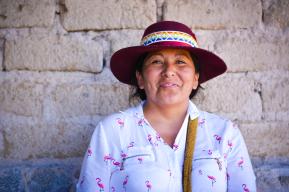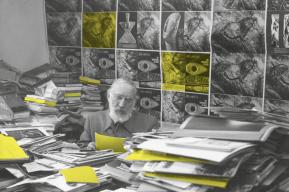Publication
Villa Ocampo, Victoria’s masterpiece


Natalia Páez
Argentinean journalist
Every November, in the final years of the 19th century, the entire Ocampo family went to the Retiro station in Buenos Aires to take the train to San Isidro, some twenty kilometres north of the capital. The procession of about twenty people included the daughters’ tutors and servants, who were responsible for maintaining the furniture, the house, the barns, henhouse, stables and gardens.
On arrival, they traveled through a five-kilometre thick wood in a horse-drawn carriage, leaving the estuary and a landscape of feather reed grass behind them, and then made their way to Beccar, where Villa Ocampo stands. This house, built by Victoria's father on a ten-hectare site, served as the family's summer residence. She would stay there every year until March, as the southern autumn approached.
At that time, San Isidro was a small town on the banks of the world’s widest river, the Río de la Plata. Traditional Buenos Aires families came here to spend the summer months. When Villa Ocampo was first built, this vast expanse of land, bounded by the Andean peaks to the west and the Atlantic Ocean to the east, had been called the Argentine Republic for barely 38 years.
The construction of the house practically coincided with the birth, in April 1890, of the eldest of the six daughters – Victoria. And indeed, the history of this building, listed as a National Historic Monument in 1997, is interwoven with the destiny of the woman who was to become one of the most influential figures in the Argentine cultural milieu of the 20th century.
Multiple lives
Writer, essayist, translator, philanthropist and patron of the arts, Victoria Ocampo lived a thousand lives. A liberated woman, impossible to define, even by her own family, she was also a pioneer of feminism. In 1936 she was one of the founders of the Argentine Women's Union. An activist, she fought fascism and campaigned for women's right to vote.
A liberated woman and activist, Victoria Ocampo was one of the most influential figures in the Argentine cultural milieu of the 20th century
But her activism was also, above all, literary. In 1931, she founded the magazine Sur, to which the famous Argentine writer Jorge Luis Borges contributed, as well as other leading authors such as Ernesto Sabato, Ezequiel Martínez Estrada, Adolfo Bioy Casares, and her younger sister, the outstanding writer Silvina Ocampo.
A great traveller, Victoria made the Villa Ocampo her main residence in 1941, when she was in her early fifties. The villa tells her story like an open book, from childhood to her death at the age of 88 in 1979.
Her presence still echoes in the first-floor room, where she studied French and English with her tutors as a child. From the balcony overlooking the river, we can imagine her dreaming of a destiny free from the conventions of her class. The teenage Victoria inhabits the music room in the form of a portrait by the French artist Dagnan Bouveret (1910). Her imprint can also be found in the imposing library, with over one hundred metres of shelves.

Mythical place
Victoria Ocampo succeeded in transforming a 19th-century house into a mythical place. She filled it with objects brought back from her travels and modernised its Victorian-style interior, with its dark walls and classical paintings.
Each of the many rooms in the house bears her mark. Like the music room, which she had painted white, where objects such as lacquered Chinese cabinets with bronze locks are on show. A Steinway piano, on which the Russian composer Igor Stravinsky and the pianist Arthur Rubinstein played, holds pride of place.
The dining room, with a table set for 16, its rustic cane chairs and its Bauhaus-style lamps chosen by Victoria, is a reminder of the vibrancy, the dinners and receptions that often punctuated the life of this holiday home. In the south wing, the high ceilings and thick walls of the building, which was designed for summer, keep the air cool. So, each room has been equipped with a marble fireplace, to take the edge off nights cooled by the humid river breeze.
Lifetime project
It was on the ground floor that Victoria received her friends. A bust of her, wearing a hat and silk scarf, still seems to rule over her world. The ground-floor living room was reserved for debates and literary meetings. According to Ernesto Sabato, some discussions could last from six to eight hours.
A home away from the hustle and bustle of the capital, a link with childhood, over the years the Villa Ocampo became the very embodiment of Victoria’s life project – an intellectual melting pot where great artists and thinkers of her time met and the point of departure for a conversation kept alive by creators from all over the world.
Villa Ocampo became an intellectual melting pot where some of the greatest creative minds of the 20th century crossed paths
Borges had his regular habits here. The architect Le Corbusier, the writers Graham Greene, Saint-Exupéry, Federico García Lorca, Octavio Paz, Albert Camus and Rabindranath Tagore stayed here, sometimes for a few hours, sometimes for weeks. “I see Villa Ocampo as a place that belongs to us and to anyone who wants to come and contribute something precious, a place where those passionate about the same issues can share their experiences, exchange information, compare, receive and give,” wrote Victoria.

Continuing the dialogue
It was to ensure that the spirit she instilled in this house would not die with her that Victoria Ocampo decided, together with her sister Angélica, to bequeath her house-creation to the UN agency dedicated to science, culture and education in 1973. She knew Julian Huxley, the first Director-General of UNESCO, and her friendship with André Malraux, the French Minister of Culture from 1959 to 1969, is not unrelated to the gesture.
In 2003, Villa Ocampo was restored in keeping with the place that Victoria Ocampo created and lived in, right down to the wallpaper in the bathroom. It opened to the public in 2006 as a historic house, a laboratory of ideas, reflection and creativity, a venue for concerts and meetings, and a documentation centre. Today, it continues the intercultural dialogue initiated by Victoria.
“The alignment of Victoria Ocampo’s values with UNESCO’s principles justified the donation of the house by the Ocampo sisters. By fostering dialogue and multilateral collaboration as well as by providing a platform for reflection and action in important areas such as cultural diversity, sustainable development, education, science, communication and culture, we actively contribute to the promotion and preservation of Victoria's heritage,” says Alcira Sandoval Ruiz, Culture Programme Officer at the UNESCO office in Montevideo, where the villa is located.
“The greatest pride of my house is to have welcomed men like him [Albert Camus] sitting in the sun, in a wicker armchair, or by the fireplace, with a cup of coffee in his hand,” Victoria Ocampo once wrote. “I don’t collect valuable paintings, rare books, exotic silver objects, etc. I have only collected things that are of value to me. I have only collected footsteps and voices.”
Villa Ocampo in figures
More information on the Instagram account @villa_ocampo










